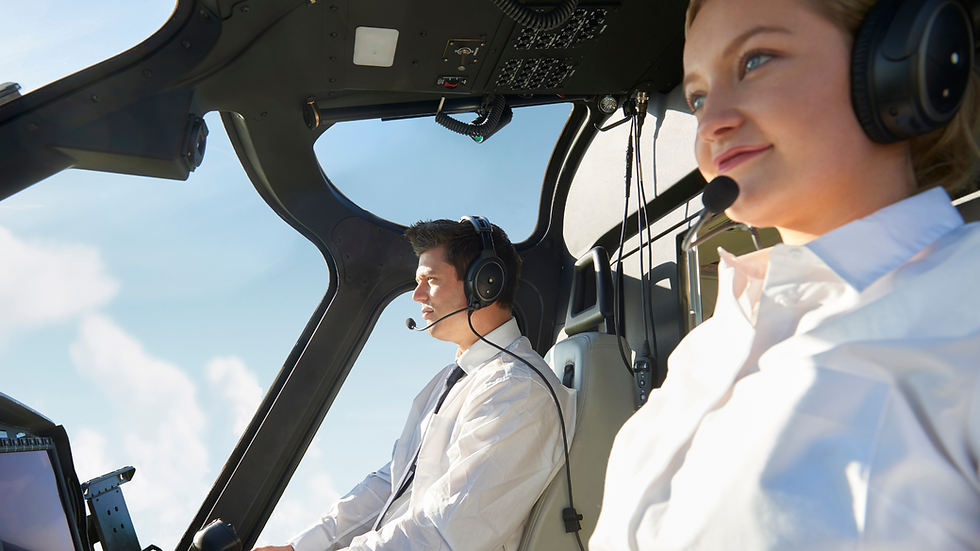“Oh, You’re a Woman!” Why the Skies Are Still Dominated by Men and How That Might Change
- Shreya Majumder
- May 19
- 4 min read

Step onto almost any commercial flight in the UK or the US, and the odds are strong that a man will be in the cockpit. Despite decades of progress across many industries, aviation remains one of the most male-dominated professions. So why are women still so underrepresented as pilots – and what can be done to change that?
Still Breaking Barriers
Maria Pernia-Digings, 61, a senior captain at easyJet, has been flying since 1990. With over 16,000 flight hours under her belt, her professionalism is unquestionable, yet she still receives comments that highlight how rare it is for passengers to see a woman at the controls. Some even congratulate her on “parking the plane well.” Pernia-Digings tries to brush it off with a smile, but the message is clear: even now, a female pilot is still a surprise.
“It’s lovely that people are supportive,” she says. “But it’s a bit sad that someone thinks I can’t park just because I’m a woman.”
Despite more than a decade of diversity initiatives, only 6.5% of pilots in the UK are women. The figures drop even further when it comes to captains.
The Gender Pay Divide
The gender imbalance isn’t just a numbers game; it directly influences pay. At easyJet, where women make up only 12% of the top-paying roles and 73% of the lowest, the median hourly wage for women is just 53p for every pound earned by men. Their bonus pay is almost 28% lower.
Other airlines report similar or worse figures. Ryanair’s median pay gap is 57.8%, while BA CityFlyer sits at 39%, and Virgin Atlantic at 28.4%.
These gaps largely reflect the distribution of roles: men dominate the cockpit and engineering, while women make up most cabin crew – a role that pays significantly less.

An Industry Frozen in Time
In easyJet’s Gatwick training centre, the divide is stark. Male trainee pilots lounge comfortably in small groups, while female cabin crew huddle around a single table. Hannah Wells, a first officer and pilot training manager, sees the imbalance every day. “There aren’t any practical barriers. It’s just that women often don’t consider this career path,” she says.
Some Progress, But Still Slow
easyJet has raised its female pilot percentage to 7.5%, slightly above the national average. Thirteen percent of its current trainees are women. It's progress — but modest.
Flexible scheduling options and new family-friendly policies, such as early return flights and even a lactation room at the training centre (though it remains unused), show efforts are being made to accommodate parents. Still, the cultural shift remains slow.
Wells, who previously worked in automotive engineering, believes more outreach is needed. “I tell schoolkids that you can apply to be a pilot with just five GCSEs. You don’t need A-levels. The job should feel accessible.”
Facing Cultural Resistance
For many women, the obstacles aren’t physical but cultural. Isabelle Lane, 21, a trainee pilot, says people are often surprised – though pleasantly – when she tells them her profession. She’s one of the few women in her flying cohort and has seen the same imbalance in training schools.
Global research shows the bias runs deep. A 2021 study by Embry-Riddle Aeronautical University found that both passengers and pilots rated white male pilots higher than women and ethnic minority peers, based on nothing more than photographs.
The perception that women must have benefited from quotas or “special treatment” is still common. One review of the aviation industry referred to this ingrained bias as the “glass sky” a stubborn ceiling reinforced by outdated ideas of who belongs in the cockpit.
Pilot training is also prohibitively expensive – often over £100,000 and self-funded. That financial burden, combined with the expectation that women will take career breaks for children, may discourage many from pursuing it in the first place.
Veteran US pilot Karlene Petitt recalls facing judgment both at work and at home. She eventually switched to a trainer role to better balance parenting responsibilities. “There’s still a stigma that if women do this job, they’re not good mothers,” she says. Her male peers, by contrast, continued their careers uninterrupted.

Interestingly, India has one of the highest percentages of female pilots globally — over 15%. That’s not due to diversity programmes, but rather the country's fast-growing aviation sector, which is creating more opportunities for everyone, including women.
In contrast, efforts in the US are being hindered by political opposition. Some leaders have blamed diversity, equity, and inclusion (DEI) initiatives for aviation accidents, despite a lack of evidence. This backlash threatens to undo progress in building a more inclusive workforce.
Looking Forward
Despite the barriers, pilots like Pernia-Digings remain passionate about their careers. “The aircraft doesn’t know the gender of the pilot,” she says. “It’s a beautiful job flying above the clouds, seeing the sun rise and set, looking down at mountains and cities. I probably have the best office view in the world.”
If the aviation industry is serious about closing the gender gap, it needs more than symbolic support. It needs sustained efforts in outreach, education, and culture to ensure that the next generation of pilots is more balanced than the last.






















